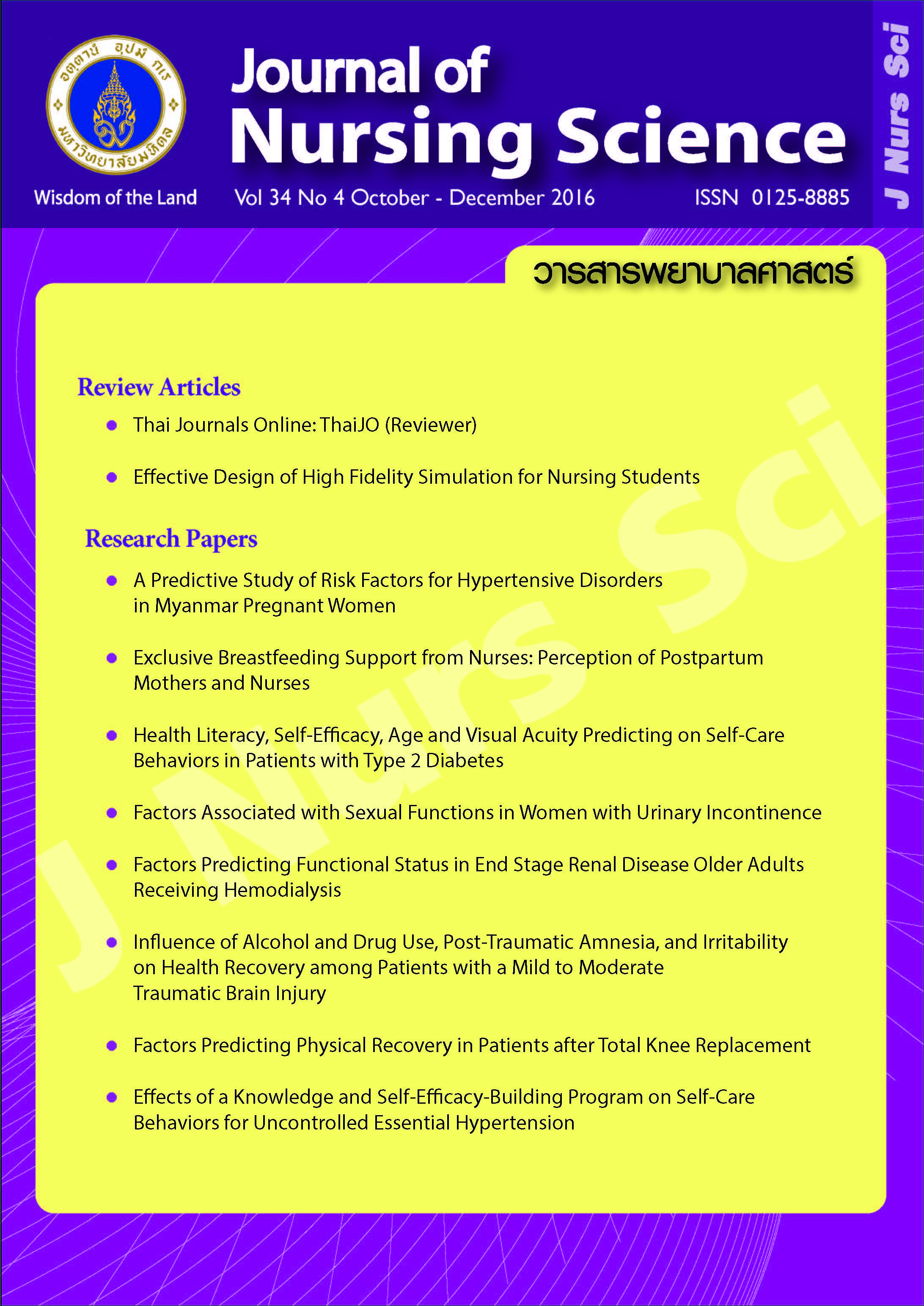Factors Associated with Sexual Functions in Women with Urinary Incontinence
Main Article Content
บทคัดย่อ
Abstract
Purpose: To investigate the relationship between severity of urinary incontinence, knowledge about sexual function, intimacy, and sexual functions in female patients with urinary incontinence.
Design: A descriptive correlation design.
Methods: The samples consisted of 92 women, aged 18 years old and above, who had been diagnosed with urinary incontinence and attended at an outpatient clinic of one University Hospital in Bangkok, Thailand. Data were collected using a demographic questionnaire, the International Consultation on Incontinence Questionnaire–Short Form, Knowledge about Sexual Function Assessment Form, Intimacy Scale, and the Female Sexual Function Index. Data were analyzed using descriptive statistics and the Spearman rank correlation coefficient.
Main findings: The results showed that the average age of the samples was 54 years old (X = 53.54, SD = 8.51). The mean score of their severity of urinary incontinence was at a moderate level (X = 8.50, SD = 4.46). The mean score of knowledge about sexual function was at a moderate level (X = 7.89, SD = 2.74), while the mean score of sexual function was at a dysfunction level. The mean score of intimacy with their spouse or partner was at a high level (X = 66.63, SD = 11.36). Their
knowledge on sexual functions was positively related to sexual functions (r = .28, p < .05). Intimacy was also positively related to their sexual functions (r = .32, p < .05). However, there was no significant relationship between severity of urinary incontinence and sexual functions in this group of patients.
Conclusion and recommendations: Based on the findings, the researchers recommended that nurses and healthcare providers should assess sexual function of female patients having urinary incontinence, and provide appropriate knowledge about sexual function for them. Moreover, intimacy between the couples or partners should be enhanced to promote better sexual functions in these women.
ปัจจัยที่มีความสัมพันธ์ต่อการทำหน้าที่ทางเพศในผู้หญิงที่มีภาวะกลั้นปัสสาวะไม่อยู่
บทคัดย่อ
วัตถุประสงค์: เพื่อศึกษาความสัมพันธ์ระหว่างความรุนแรงของภาวะกลั้นปัสสาวะไม่อยู่ความรู้เกี่ยวกับการทำหน้าที่ทางเพศ ความใกล้ชิดสนิทสนม กับการทำหน้าที่ทางเพศในผู้หญิงที่มีภาวะกลั้นปัสสาวะไม่อยู่
รูปแบบการวิจัย: การวิจัยครั้งนี้เป็นการวิจัยเชิงบรรยาย
วิธีดำเนินการวิจัย: กลุ่มตัวอย่างเป็นผู้ป่วยหญิงที่มีภาวะกลั้นปัสสาวะไม่อยู่ จำนวน 92 ราย ที่มารับการตรวจรักษาแบบผู้ป่วยนอกที่โรงพยาบาลมหาวิทยาลัยแห่งหนึ่ง ในกรุงเทพมหานคร มีอายุตั้งแต่ 18 ปีขึ้นไป เก็บข้อมูลโดยใช้แบบสอบถามข้อมูลส่วนบุคคล แบบประเมินความรุนแรงของอาการกลั้นปัสสาวะไม่อยู่แบบประเมินความรู้เกี่ยวกับการทำหน้าที่ทางเพศ แบบประเมินความใกล้ชิดสนิทสนม และแบบประเมินการทำหน้าที่ทางเพศ วิเคราะห์ข้อมูลโดยใช้สถิติเชิงบรรยายและสัมประสิทธิ์สหสัมพันธ์สเปียร์แมน
ผลการวิจัย: กลุ่มตัวอย่างมีอายุเฉลี่ย 54 ปี (X = 53.54, SD = 8.51) โดยรวมมีคะแนนเฉลี่ยของความรุนแรงของภาวะกลั้นปัสสาวะไม่อยู่ในระดับปานกลาง (X = 8.50, SD = 4.46) ความรู้เกี่ยวกับการทำหน้าที่ทางเพศอยู่ในระดับปานกลาง (X = 7.89, SD = 2.74) ความใกล้ชิดสนิทสนมระหว่างคู่สมรสอยู่ในระดับสูง (X = 66.63, SD = 11.36) ใน
ขณะที่การทำหน้าที่ทางเพศอยู่ในเกณฑ์บกพร่อง (X = 17.89, SD = 6.83) ความรู้เกี่ยวกับการทำหน้าที่ทางเพศมีความสัมพันธ์ทางบวกกับการทำหน้าที่ทางเพศของกลุ่มตัวอย่าง อย่างมีนัยสำคัญทางสถิติ (r = .28, p < .05) และความใกล้ชิดสนิทสนม มีความสัมพันธ์ทางบวกกับการทำหน้าที่ทางเพศของกลุ่มตัวอย่าง อย่างมีนัยสำคัญทางสถิติ (r = .32,
p < .05) อย่างไรก็ตาม ความรุนแรงของอาการกลั้นปัสสาวะไม่อยู่ ไม่มีความสัมพันธ์กับการทำหน้าที่ทางเพศในผู้หญิงที่มีภาวะกลั้นปัสสาวะไม่อยู่
สรุปและข้อเสนอแนะ: จากผลการศึกษาครั้งนี้ ผู้วิจัยเสนอแนะว่า ทีมสุขภาพควรมีประเมินการทำหน้าที่ทางเพศในผู้ป่วยหญิงที่มีภาวะกลั้นปัสสาวะไม่อยู่ และควรมีการให้ความรู้ที่เหมาะสมเกี่ยวกับการทำหน้าที่ทางเพศแก่ผู้ป่วย รวมทั้ง สนับสนุนการสร้างความใกล้ชิดระหว่างคู่สมรส เพื่อส่งเสริมการทำหน้าที่ทางเพศในผู้ป่วยหญิงที่มีภาวะกลั้นปัสสาวะไม่อยู่
คำสำคัญ : ภาวะกลั้นปัสสาวะไม่อยู่ ความรุนแรงของภาวะกลั้นปัสสาวะไม่อยู่ ความรู้เกี่ยวกับการทำหน้าที่ทางเพศ ความใกล้ชิดสนิทสนม ผู้หญิง
Article Details
ลิขสิทธิ์: วารสารพยาบาลศาสตร์เป็นเจ้าของลิขสิทธิ์ในการเผยแพร่ผลงานที่ตีพิมพ์ ห้ามผู้ใดนำบทความที่ได้รับการตีพิมพ์ในวารสารพยาบาลศาสตร์ไปเผยแพร่ในลักษณะต่างๆ ดังต่อไปนี้ การส่งบทความไปตีพิมพ์เผยแพร่ที่อื่น การนำบทความเผยแพร่ออนไลน์ การถ่ายเอกสารบทความเพื่อกิจกรรมที่ไม่ใช่การเรียนการสอน ยกเว้นเสียแต่ได้รับอนุญาตจากวารสารพยาบาลศาสตร์

Disclaimer: เนื้อหาบทความหรือข้อคิดเห็นใดๆ ในวารสารพยาบาลศาสตร์ ถือเป็นความรับผิดชอบของผู้เขียน กองบรรณาธิการไม่จำเป็นต้องเห็นด้วยและไม่มีส่วนรับผิดชอบแต่อย่างใด


